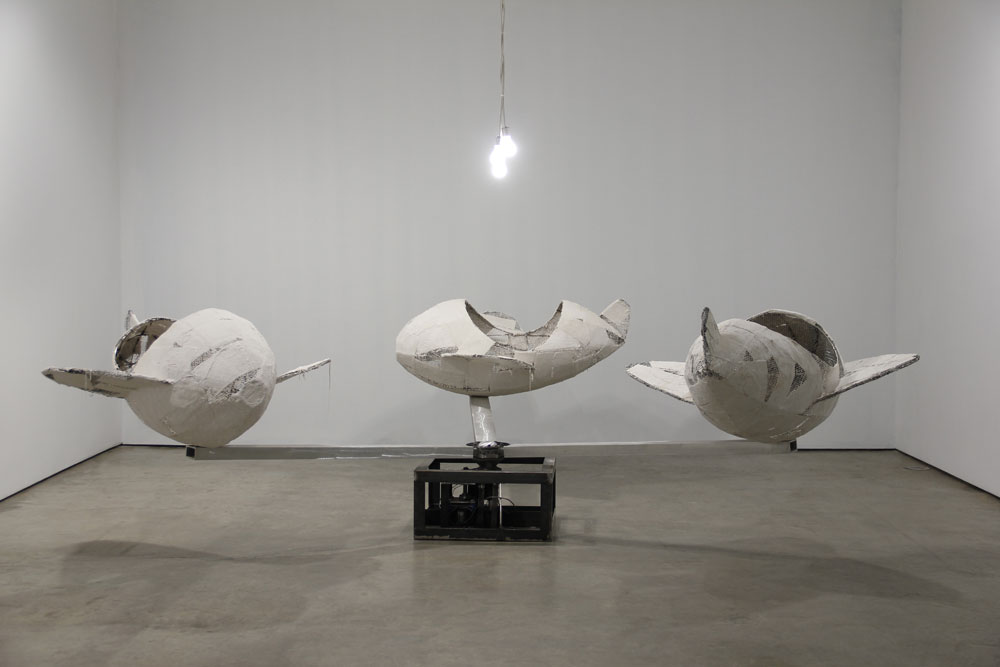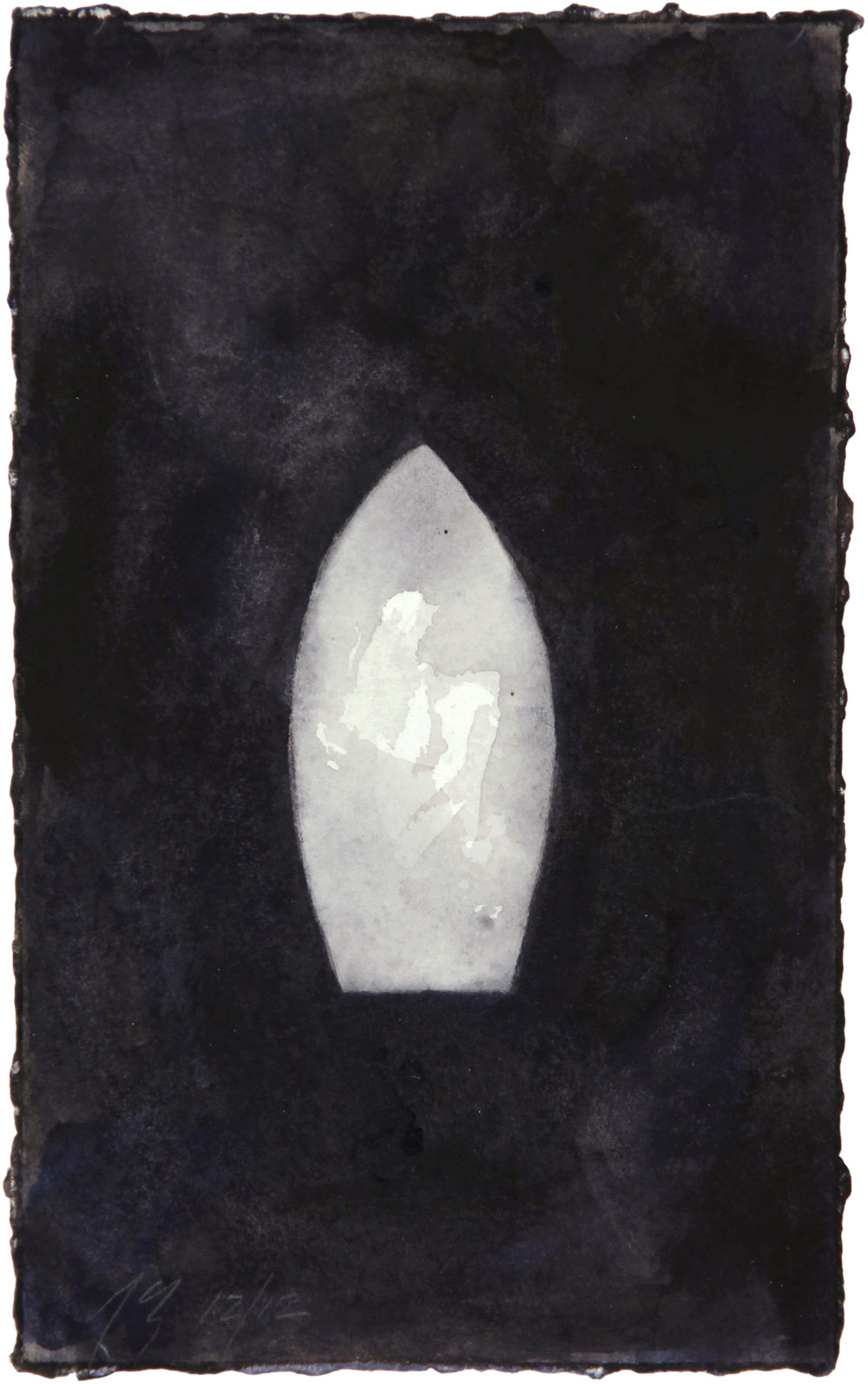
Poetics of the Unpromising
September 4, 2013 · by Alana Shilling
 Inversion, 2012, 13' diameter, Hydrostone, Steel, Aluminum, Motor
Inversion, 2012, 13' diameter, Hydrostone, Steel, Aluminum, Motor
When an exhibition titled Tempus Fugit surfaces, it would seem wise to gird the loins for another pageant of pretension that aspires to the hermetic yet achieves only self-parody. Even the suggestion of erudition that Latinity bestows on the exhibition’s title is undermined by its source, Virgil’s Georgics, a didactic poem on farming in which the titular phrase appears in a discussion of animal husbandry. Goat breeding is hardly the stuff from which the gossamer of ineffable temporality is spun.
Joseph Zito: Tempus Fugit, currently on view at Lennon, Weinberg, Inc., features seven sculptures—two mechanized—and 11 works on paper. As an exhibition of Zito’s mechanized sculptures with other works occupying secondary roles, Tempus Fugit appears glib and sophomoric. To represent commerce with the past through works that betray their awkward construction, groaning in their weary backwards course, seems obvious, clumsy. But a critic’s smug detection of superficiality is no explanation—it merely substitutes one kind of surface for another.
As the apotheosis of return to the past, the mechanized sculptures are graceless failures. But that is precisely the point. Tempus Fugit is less an attempt to represent a return than it is an invitation to experience the merging of discontent and hope that fires the yearning for that return. The mechanized sculptures form part of a discourse shaped by dialogue with the works mounted on the surrounding walls. The discourse unfolds twice, each time dominated by a single shape: first a boat, then a plane.
A Post-Minimalist discipline rules the works on paper, wherein Zito repeats each shape with perfect discipline, placing the form deliberately, often symmetrically on the page—even ships askew seem disordered by design. The boats, which appear emphatically flat, becalmed, are often magnolia white. Each one is set against a sea of pigment at once vibrant and mercurial. This intensity often imbues the boats with a sense of otherness, as in one of the works on paper, “Study for ‘Adrift’” (2012). There, the form is perfectly centered in a field of turbulent Russian violet foaming to grey, inspiring the impression that the boat is mere absence—or interloper, cut from the composition altogether or superimposed, thrust into a watercolor tempest.
 Study for 'Adrift', Watercolor, 4½″×7¼″, 2012
But these works are neither mere preludes to the mechanized sculptures nor simple representations
of them. The spare composition of each drawing not only focuses attention on pure form but also
undermines the primacy of the work, insinuating that its significance lies beyond itself. One might
imagine such significance coalescing in the mechanized sculpture “Untitled (Clock)” (2012), which
makes two dimensions three, and stasis motion. Three hollow-hulled wooden boats crown the
“hands” of an implied clock, which cleaves a reverse course through the air in a seeming
crystallization of the wish to evade time. And yet the sculpture is no Galatea. The conceit is as
inelegantly expressed as the very design of the “clock,” throbbing with irregular beats. This
incarnation of recapturing the past is unsatisfying. It is meant to be.
Study for 'Adrift', Watercolor, 4½″×7¼″, 2012
But these works are neither mere preludes to the mechanized sculptures nor simple representations
of them. The spare composition of each drawing not only focuses attention on pure form but also
undermines the primacy of the work, insinuating that its significance lies beyond itself. One might
imagine such significance coalescing in the mechanized sculpture “Untitled (Clock)” (2012), which
makes two dimensions three, and stasis motion. Three hollow-hulled wooden boats crown the
“hands” of an implied clock, which cleaves a reverse course through the air in a seeming
crystallization of the wish to evade time. And yet the sculpture is no Galatea. The conceit is as
inelegantly expressed as the very design of the “clock,” throbbing with irregular beats. This
incarnation of recapturing the past is unsatisfying. It is meant to be.
The works on paper in this first grouping highlight the folly of hoping to reverse time by mechanical means. Meanwhile, their simplicity becomes possibility: on paper, the boat is at turns skiff, cenotaph, monument. In “The End”(2013), the boat sinks, mired in clotted imperial red. It rises from ruddy ash-lands like a phantom phoenix in “85004”(2013). In short, the relationship between sculpture and works on paper is not one of teleology but of subjunctive possibility, enabled by the perennial ability to move backward to the studies, which might once have come before the sculpture, but which in contemplation exceed it. It is not the sculpture, but dissatisfaction with it that leads the viewer back in time, back to the what-could-have-been watercolor world.
A similar dynamic structures the second formal grouping, united by the plane. Here, the return to the past is less arid and theoretical—it is instead infused with nostalgia for childhood. Thirteen feet in diameter, the sculpture “Inversion”(2012)consists of three small planes beating a perpetual counterclockwise course. Its ancestor is the species of quarter-fed rides once native to supermarket parking lots and so dear to children’s hearts. “Inversion” appears a corroded carousel plodding backward at a glacial pace. Though the sculpture’s movement seems labored and uncertain, the crimson planes in surrounding drawings stand against plain backgrounds, tinted only by occasional rivulets of pigment seeping from the forms themselves.
In his Laocoon, 18th-century writer Gotthold Lessing dictated that poetry represents time in its narratives while the visual arts can show only space. Tempus Fugit is more than an exploration of a fantasy—and perhaps even more than an excavation of the desire that whelps it. Zito’s works manage to represent temporality spatially, while the spatial takes purest form in time—the time we imagine, the time we create, the time for which we long even now.